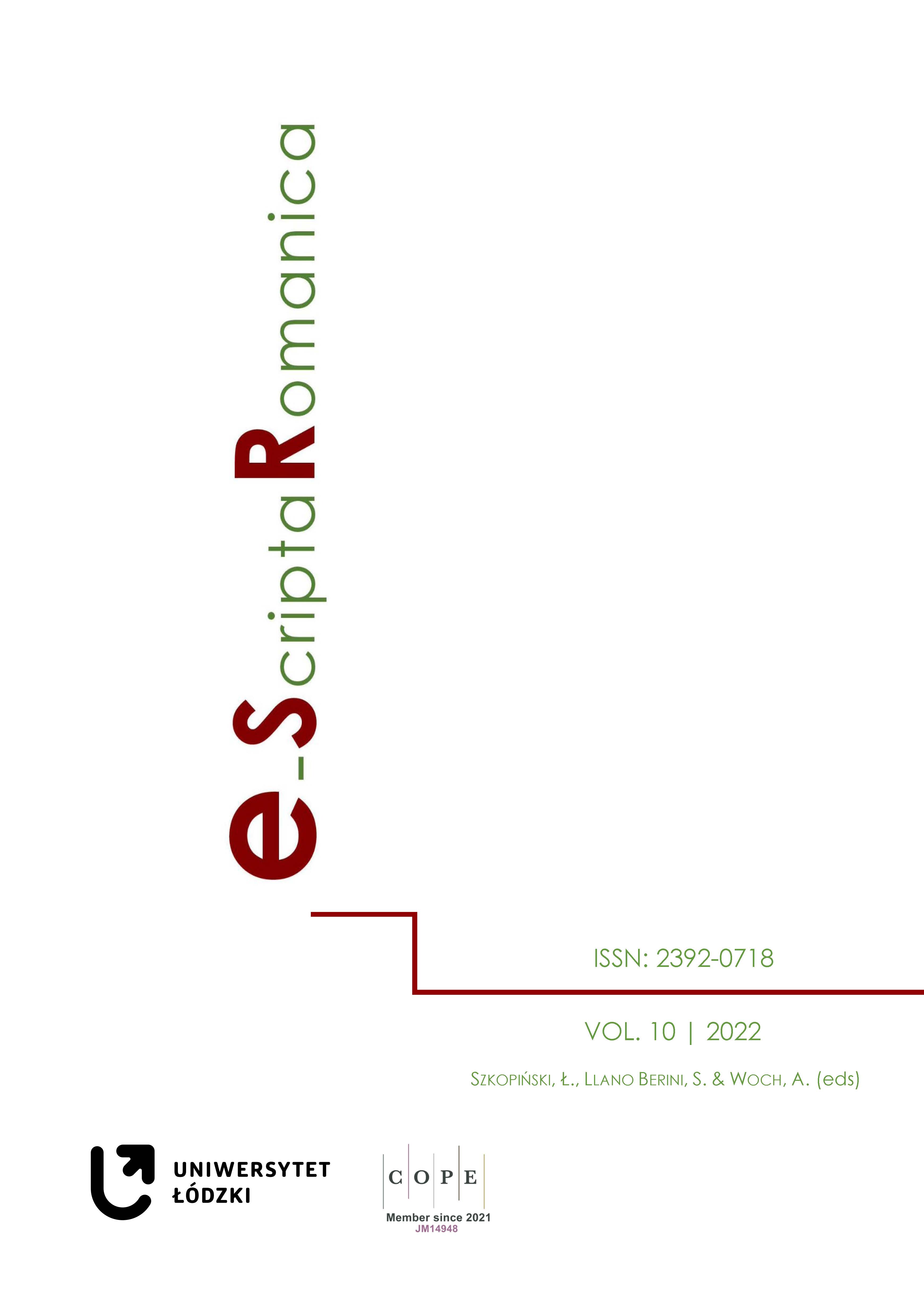El mantenimiento de una unidad fraseológica en la diacronía: tiempos verbales en las construcciones indefinidas con gana
DOI :
https://doi.org/10.18778/2392-0718.10.02Mots-clés :
cambio lingüístico, dar, gana, construcción, indefiniciónRésumé
El estudio se centra en el componente verbal de las construcciones indefinidas con dar la gana y dar gana. Los resultados apuntan a que dar la gana se expandió morfológicamente a otros tiempos verbales; mientras que dar gana presenta en el español contemporáneo un descenso en los tiempos verbales en los que aparece. Se concluye que la primera se fijó en las construcciones indefinidas volviéndose productiva, y la segunda no. Asimismo, en los resultados se observa una alternancia entre el indicativo y el subjuntivo. El hecho se asocia a la distinción entre específico y no específico.
Références
AHERN, A. (2008). El subjuntivo: contextos y efectos. Madrid: Arco Libros.
Google Scholar
ALBA-SALAS, J. (2012). The origins and evolution of inchoative collocations with ‘dar’ in Spanish. Romance Philology, 66(2), pp. 365-395.
Google Scholar
DOI: https://doi.org/10.1484/J.RPH.5.100844
BELLO, A. (2002). Gramática de la lengua castellana destinada al uso de los americanos. Alicante: Biblioteca Virtual Miguel de Cervantes. http://www.cervantesvirtual.com/obra/gramatica-gramatica-de-la-lengua-castellana-destinada-al-uso-de-los-americanos--0/ [27/04/2017].
Google Scholar
COMPANY COMPANY, C. & POZAS LOYO, J. (2009). Los indefinidos compuestos y los pronombres genérico-impersonales omne y uno. In COMPANY COMPANY, C. (ed.), Sintaxis histórica de la lengua española. Segunda parte: La frase nominal, vol. 2. México: UNAM/FCE, pp. 1073-1219.
Google Scholar
Corpus del Nuevo diccionario histórico del español (CDH), versión 3.1. Real Academia Española. http://web.frl.es/CNDHE/ [21/02/2020].
Google Scholar
FERNÁNDEZ RAMÍREZ, S. (1987). Gramática española. 3.2. El pronombre. Madrid: Arco-libros.
Google Scholar
HASPELMATH, M. (1997). Indefinite pronouns. Oxford: Oxford University Press.
Google Scholar
HAWKINS, J. A. (1978). Definiteness and indefiniteness. A study in reference and grammaticality prediction. London; New York: Routledge.
Google Scholar
HAWKINS, J. A. (1991). On (in)definite articles: Implicatures and (un)grammaticality prediction. Journal of Linguistics, 27(2), pp. 405-442.
Google Scholar
DOI: https://doi.org/10.1017/S0022226700012731
HIMMELMANN, N. (2004). Lexicalization and grammaticization: Opposite or orthogonal? In BISANG, W., HIMMELMANN, N. P. & WIEMER, B. (ed.), What makes grammaticalization? A look from its fringes and its components. Berlin-New York: De Gruyter, pp. 21-42.
Google Scholar
HOPPER, P. J. & TRAUGOTT, E. C. (2003). Grammaticalization. Cambridge: Cambridge University Press.
Google Scholar
DOI: https://doi.org/10.1017/CBO9781139165525
JIMÉNEZ MARTÍNEZ, M. I. & MELIS, CH. (2018). Evolución de las colocaciones causativas emocionales del latín al español. Anuario de letras, 6(2), pp. 75-109.
Google Scholar
DOI: https://doi.org/10.19130/iifl.adel.6.2.2018.1519
LEHMANN, CH. (1985). Grammaticalization: synchronic variation and diachronic change. Lingua e Stile, 20, pp. 303-318.
Google Scholar
LEHMANN, CH. (2002). Thoughts on grammaticalization. Erfurt: Universität Erfurt (Arbeitspapiere des Seminars für Sprachwissenschaft der Universität Erfurt, 9).
Google Scholar
LEONETTI, M. (1999). El artículo. In BOSQUE, I. & DEMONTE, V. (ed.), Gramática descriptiva de la lengua española, vol. 1. Madrid: Espasa Calpe, § 12.
Google Scholar
LYONS, CH. (1999). Definitenes. Cambridge: Cambridge University Press.
Google Scholar
DOI: https://doi.org/10.1017/CBO9780511605789
MAJÍAS-BIKANDI, E. (1994). Assertion and speaker’s intention. A pragmatically based account of mood in Spanish. Hispania, 77(4), pp. 892-902.
Google Scholar
DOI: https://doi.org/10.2307/345752
MENÉNDEZ PIDAL, R. (1985). Manual de gramática histórica española. Espasa-Calpe: Madrid.
Google Scholar
PÉREZ SANDANYA, M. (1999). El modo en las subordinadas relativas y adverbiales. In BOSQUE, I. & DEMONTE, V. (ed.), Gramática descriptiva de la lengua española, vol. 2. Madrid: Espasa Calpe, § 50.
Google Scholar
RIVERO, M.-L. (1988). La sintaxis de qual quiere y sus variantes en el español antiguo. Nueva Revista de Filología Hispánica, 36(1), pp. 47-73.
Google Scholar
DOI: https://doi.org/10.24201/nrfh.v36i1.663
RUIZ VELASCO D., L. (2019). Las construcciones de indefinición y el rol del contexto. Revista de investigación lingüística, 22, pp. 451-465.
Google Scholar
DOI: https://doi.org/10.6018/ril.375571
RUIZ VELASCO D., L. (2020a). Desarrollo sintáctico de una familia de construcciones con gana y fijación de las construcciones de indefinición con ‘dar la gana’. Nueva Revista de Filología Hispánica, 68(1), pp. 67-103.
Google Scholar
DOI: https://doi.org/10.24201/nrfh.v68i1.3583
RUIZ VELASCO D., L. (2020b). Entre la gramaticalidad y la expresividad: el caso de dar la gana. Revista de Historia de la Lengua Española, 15, pp. 195-213.
Google Scholar
DOI: https://doi.org/10.54166/rhle.2020.15.06
TERRELL, T. & HOOPER, J. (1974). A semantically based analysis of mood in Spanish. Hispania, 57(3), pp. 484-494.
Google Scholar
DOI: https://doi.org/10.2307/339187
TRAUGOTT, E. C. & TROUSDALE, G. (2013). Constructionalization and constructional changes. Oxford: Oxford University Press.
Google Scholar
DOI: https://doi.org/10.1093/acprof:oso/9780199679898.001.0001
Téléchargements
Publiée
Comment citer
Numéro
Rubrique
Licence

Ce travail est disponible sous licence Creative Commons Attribution - Pas d'Utilisation Commerciale - Pas de Modification 4.0 International.











